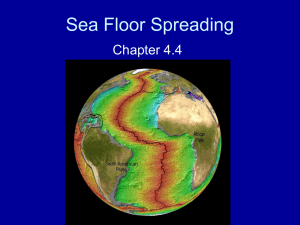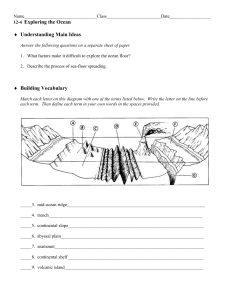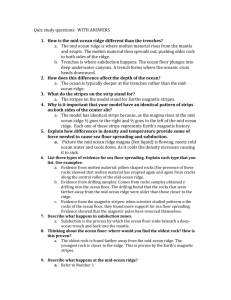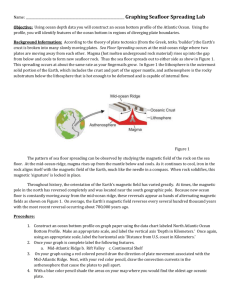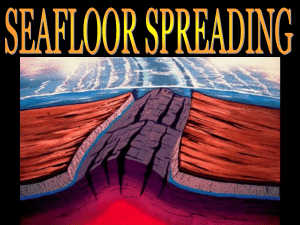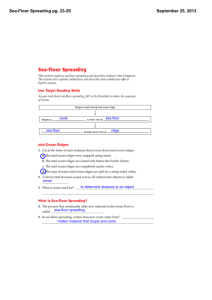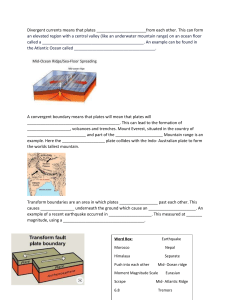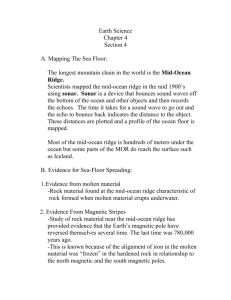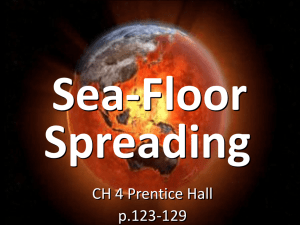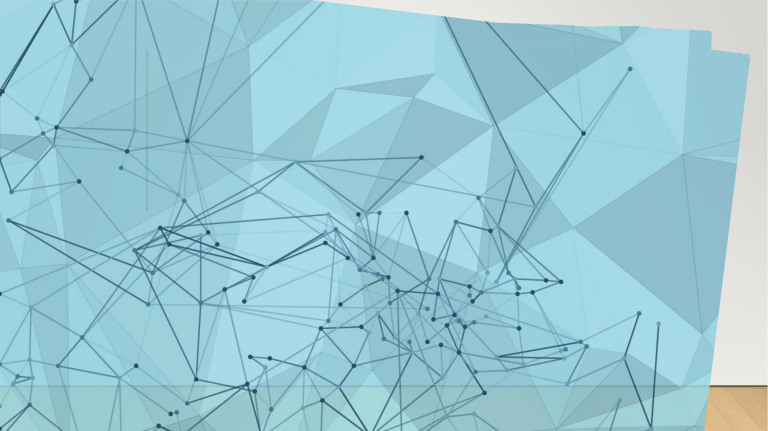
ACTIVITY 1 CRACK THE CODE Crack the CODE using the DECODING pieces below. A B C D E F G H I A B C D E F G H I J K L M N O P Q R J K L M N O P Q R S T U V W X Y Z S T U V W X Y Z 1. C O N V E C T I O N 2. M A N T L E 3. J I G S A W F I T 4. S O N A R 5. M A G N E T I C R E V E R S A L Sea Floor Spreading EQ: What is the process of seafloor spreading? Sonar • Sonar: A device that determines the distance of an object under water by recording echoes of sound waves The sonar is used to map the ocean floor Sonar bounces sound waves off underwater objects and then records the echoes of these sound waves The time it takes for the echo to arrive indicates the distance to the object Mid-Ocean Ridge • Mid-Ocean Ridge: The undersea mountain chain where new ocean floor is produced; a divergent plate boundary Mid Ocean Ridge Sea-Floor Spreading The process by which molten material adds new oceanic crust to the ocean floor Diagram of Seafloor Spreading Subduction Zone Evidence for Sea-Floor Spreading In the 1960s, Harry Hess examined maps of the mid ocean ridge. He proposed that the ocean floors move like conveyor belts, carrying the continents with them. What evidence did scientists find for sea-floor spreading in the 1960s? - Evidence from molten material - Evidence from magnetic stripes - Evidence from drilling Evidence From Molten Material 1. Rocks are younger at the mid-ocean ridge. 2. Rocks far from the mid-ocean ridge are older. 3. Sediments are thinner at the ridge. 4. Rocks at the ocean floor are younger than those at the continents. Evidence From Magnetic Stripes Scientists discovered that the rock that makes up the ocean floor lies in a pattern of magnetized “stripes” 780,000 years ago, magnetic poles reversed themselves • If they reversed today, the needle in a compass would point south instead of north The rock in the ocean is made of iron, which began as molten material Evidence From Drilling Samples • When scientists sampled the rocks, they found that the further away from the ridge the rocks were the older they were • The younger rocks were always in the center of the ridges Deep-Ocean Trenches • A deep valley along the ocean floor through which oceanic crust slowly sinks towards the mantle Subduction at Deep-Ocean Trenches Diagram of Seafloor Spreading Subduction Zone Subduction • Subduction: The process by which oceanic crust sinks through a deepocean trench and back into the mantle; a convergent plate boundary Guide For Reading: What happens to the ocean floor at deep ocean trenches? • At deep-ocean trenches, two plates collide causing the denser of the two plates to dive back to the mantle. This process is known as subduction. • Over tens of million of years, this material melts back into molten material and may rise again as new oceanic crust. Guide For Reading: What is the process of sea-floor spreading? • At the mid-ocean ridge, molten material rises from the mantle and erupts. The molten material then spreads out, pushing older rock to both sides of the ridge. • Over tens of millions of years, the process continues until the oldest ocean floor collides with the continental crust • The more dense oceanic crust subducts (sinks) back into the mantle at a deep-ocean trench Subduction and Earth’s Oceans Subduction in the Pacific Ocean • Subduction in the Pacific Ocean is occurring at a greater rate than seafloor is expanding • This is caused by the large amount of trenches Subduction in the Atlantic • The Atlantic Ocean is expanding at a greater rate than subducting • This is because of the low number of trenches in the Atlantic • Over time the entire ocean gets larger and pushes against the continents Findings that support Seafloor Spreading Theory: 1. Rocks are younger at the mid-ocean ridge. 2. Rocks far from the mid-ocean ridge are older. 3. Sediments are thinner at the ridge. 4. Rocks at the ocean floor are younger than those at the continents. The Seafloor Spreading Theory contradicts a part of the Continental Drift Theory. According to this theory, continents moved through unmoving oceans and that larger, sturdier continents broke through the oceanic crust. Whereas, the seafloor spreading shows that the ocean is the actual site of tectonic activity. MAGNETIC REVERSAL What is Magnetic Reversal? Magnetic reversal is also called magnetic ‘flip’ of the Earth. It happens when the North Pole is transformed into a South Pole and the South Pole becomes the North Pole. This is due to the change in the direction of flow in the outer core. Activity 9 - Split and Separate! Objectives: • Simulate and describe the seafloor spreading process. • Realize the importance of the seafloor spreading process relative to the Continental Drift Theory. Materials: • board paper - pair of scissors • bond paper - ruler • colored pencil Procedure: 1. Using a colored pencil, draw stripes across one sheet of bond paper parallel to the short sides of the paper. The stripes should vary in spacing and thickness. 2. Fold the bond paper in half lengthwise. 3. Write the word “Start” at the top of both halves of the paper. It should look like the figure on the next slide. 4. Cut the bond paper in half along the dashed line to form two strips. 5. Take the board paper and make three (3) 11-cm long slits as indicated in the illustration. Procedure: 6. The two slits near the edges of the bond paper should be both 11-cm from the center slit. 7. Put the two striped strips of paper together so that the “Start” labels touch one another. 8. Insert the strips up through the center slit, then pull them toward the side slits. 9. Insert the ends of the strips into the side slits. Pull the ends of the strips as shown in the figure on the next slide and watch what happens at the center slit. Procedure: 10.Practice pulling the strips through the slits until you can make the stripes come up and go down at the same time. Guide Questions: 1. What do the stripes in the paper represent? 2. What does the middle slit represent? What occurs in this region? 3. What is the role of the mid–ocean ridge in the movement of lithospheric plates? 4. How does the new seafloor form at the mid-ocean ridge? 5. What process/es happen at the side slits? Guide Questions: 6. Is the earth getting larger and wider when plates drift away from each other? Explain briefly. Activity 10 - How Fast Does It Go! Objectives: • Analyze a magnetic polarity map. • Use legends and scales of the map properly. • Calculate the rate of seafloor spreading using magnetic clues. Materials: • magnetic polarity map • metric ruler • pencil Procedure: 1. Study the magnetic polarity map. You will be working only with normal polarity readings, these are the peaks above the baseline on the top half of the graph. 2. Place the long edge of the ruler vertically on the graph. Align the ruler with the center peak 1 of the Mid-Atlantic Ridge. 3. Determine and record the distance and age that line up with the center of peak 1 west. Repeat this process for peak 1 east of the ridge. 4. Calculate the average age and distance for this pair of peaks. Magnetic Polarity Map 5. Repeat steps 2 to 4 for the remaining pairs of normal polarity peaks. 6. Calculate the rate of movement in centimeters per year using the formula Rate = distance / time. Guide Questions: 1. How far do the plates move away from each other every year? 2. If Africa is approximately 2400 km away from the Mid Atlantic Ridge, how long ago was it when Africa was directly at or near the Mid-Atlantic Ridge? Plate Tectonic Theory What causes tectonic plates to move? This is one of the main questions that has remained unanswered since Alfred Wegener proposed the Continental Drift Theory. The Plate Tectonic Theory provided an explanation about the movement of the lithospheric plates. This theory evolved from the two former theories and was developed during the first decades of the 20th century. Plate Tectonic Theory The Earth’s lithosphere is divided into several plates. As you have already learned, these plates ride over the weak asthenosphere. There are three types of plate movements – separation of two plates (divergent), collision of two plates (convergent) and sliding past each other (transform). What facilitates the movement of the plates? Heat is produced in the core that produces convection in the mantle. This convection causes the plate to move around.
